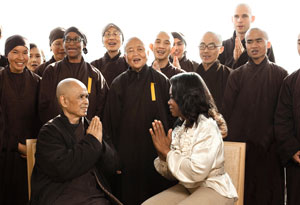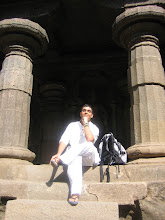It has probably happened to you at some point. You get on the subway and you see someone reading a book. At the next stop someone gets on and they begin to read a book, the same you saw before. While walking in the park, or sitting in a coffee shop, you see people reading the same book. Gradually you hear people talk about this book. You begin to wonder, what is this book about? Was it on Oprah's book of the month or something? Why are so many people reading it? Your friends and family pile on the praises for the book. Now that your interest is piqued, the next step is to acquire a copy. Maybe you go to the local library, or even try to borrow it from a friend. You could always go to a bookstore (be in person or online) but let's say that none of these options worked. You'd really like to read this book because you see that it's touched the lives of many people, so what do you do? Would you be willing to travel thousands of miles and spend decades in search of this book? Totally insane you might say, is any book worth that kind of effort? Throughout history there have indeed been such books and ones that contain the teachings of the Buddha are known as sutras.
The word sutra (pronounced 'soo-truh') is derived from the Sanskrit root 'sutr' meaning (1) "to string or put together, to contrive, effect, produce, compose". 'Sutra' itself means, "a thread, cord, string, that which works like a thread which runs through or holds everything together, rule, direction, any work or manual consisting of strings of such rules hanging together like threads". Another (related) definition is, "a carpenter's measuring line". The Pali equivalent is 'sutta' and has the same meanings (2). 'Sutra' is also etymologically related to the English word 'suture', i.e. the thread used to sew a wound closed. 'Sutra' itself is not, by any means, an exclusively Buddhist term. There are Hindu and Jain sutras too. In pop culture, the word is widely known and associated with texts like Patajali's "Yoga Sutras" and more famously the "Kama Sutra" of Vatsyayana (3).
Sutras are absolutely essential because they are THE record of the Buddha's teachings. If you walk into any bookstore and wander into the "Eastern Religions" section, you'll probably find shelves and shelves of books about what the Buddha taught. All of them ultimately have the sutras as their source material. To read about something is not quite the same as reading something directly. In the same way, being able to read through what the Buddha and his disciples actually taught gives us direct access to the profound teachings that lead to liberation from suffering.
The collection of sutras is known as the 'Sutra Pitaka" and means, "the basket of teachings". How many sutras are there? A lot. The Sutra Pitaka (in any language) consists of dozens of volumes containing thousands of sutras. This large amount of teachings often compared to a great ocean, not only because its vastness but because of its depth as well. A common expanded version of the "Taking Refuge" verses contains the follow:
I take refuge in the Dharma,and I wish that all sentient beingswill delve into the sutras,their wisdom as deep as the ocean. (4)
The sutras cover every topic from basic meditation instructions and verses on virtue to inconceivable descriptions of the highest and most exalted planes of realization. With so many texts out there, which
ones should we read? Should we even attempt to read all of them? Do we need to? These are common questions which are ones that can only really be answered by looking within. Many people engage in reading the entire Sutra Pitaka as a form of practice (5). Others stick to one sutra and delve very deeply into it. It really all depends on our practice and affinities. There are certainly some sutras which are
more popular than others such as the Heart, Anapanasati, Diamond, Lotus, Shurangama, Avatamsaka, and, Mahasatipatthana to name a few. If you've never read a sutra or would like to take a closer look,
these texts aren't a bad place to start. In studying the sutras, there are a few items that we should keep in
mind.
First, it is not possible for one sutra to be "better" or "worse" than another. Every (and I mean every!) sutra was composed for a specific audience in a specific context and has a specific message. Because of this, we might find that different sutras say different things about different topics and concepts. This does not, however, mean that one text is right and one is wrong. We can compare this idea to a doctor counseling patients. If we hear this doctor telling his first patient to eat less and then telling his second patient to eat more, we might think the doctor was being contradictory. But what if patient #1 was overweight and patient #2 was underweight? Would we still think the doctor was a quack?
The goal of every sutra is the same: lead us a step closer to liberation. Because of this, we should read/listen to them with a mind that is as calm, open, and receptive as possible. Sutras are not the sort of thing one would read in a noisy station while waiting for a crowded bus to come. Similarly, we could not fully enjoy or understand a great movie if we watched it half asleep. The right mindset for reading/reciting sutras is important enough to have lead to the tradition of reciting preliminary verses to help settle the mind. You can try it for yourself. Before opening a sutra, slowly and mindfully read its title then recite the following:
Verse for Opening a Sutra:The unsurpassed, deep, profound, subtle, wonderful Dharma,In a hundred thousand million eons, is difficult to encounter;Now that I've come to receive and hold it, within my sight and hearing,I vow to fathom the Thus Come One's true and actual meaning. (6)
***
(1) Monier-Williams Sanskrit-English Dictionary, Motilal, 2005 reprint, p. 1241
(2) Pali Text Society's Pali-English Dictionary Online p. 718.
Accessed via the "Digital Dictionaries of South Asia" Project.
(3) At a high school Interfaith presentation, I was asked, in all seriousness, if Buddhism was the "religion with the Kama Sutra" in it.
(4) From the Bodhi Monastery Liturgy:
(5) To the best of my knowledge, there is no complete English translation of the entire Sutra Pitaka although many organizations (like the Buddhist Text Translation Society) are putting much effort into changing that. I believe that a full English translation of the Pali Suttas is available from the Pali Text Society however most of the translations were done in the mid-to-late 1800s. Many of these
translations are dated and in many cases inaccurate but scholars are working hard to revise them. Its only a matter of time before all of the Buddha's teachings are available in the language of Shakespeare, Walt Whitman, and Bob Dylan.
(6) Translation from the Dharma Realm Buddhist Association.










